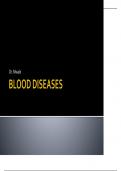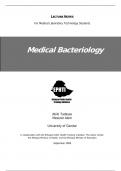Stanford University - Coursera
Latest uploads at Stanford University - Coursera. Looking for notes at Stanford University - Coursera? We have lots of notes, study guides and study notes available for your school.
-
38
- 0
-
1
All courses for Stanford University - Coursera
Latest notes & summaries Stanford University - Coursera
Blood is made up of cells, plasma and plasma proteins. Blood dyscrasias & diseases may be derived from abnormalities in the different components of blood. These include: I. Anaemia: Decrease in the number of RBCs/ Hb. II. Erythrocythemia: Increase in RBCs. Types of anaemia: May involve disorders that affect shape, size, number & level of Hb of the erythrocytes. These include: Iron deficiency anaemia Pernicious...
INTRODUCTION Blood products components prepared in a blood transfusion center (RBCs ,platelets , FFP, cryoprecipitate) or Plasma derivatives from pooled plasma donation (albumin, immunoglobulins, coagulation factors) Blood components: Derivatives from whole blood of a donor by phlebotomy. Prepared by centrifugation or apheresis. RBCs, WBCs, platelets and plasma Purpose of separation of components 1. Different components are useful for different patients 2...
EPIDEMIOLOGY 2-7 of every 1,000 births result in birth injuries despite advances in obstertic and intrapartum care Birth injuries account for 2%-3% of neonatal deaths ( 5-8 deaths per 100,000). Instrument deliveries ( vaacum or forcep) Very low birth weight or extreme prematurity Large babies – birth weight over about 4,000 grams Fetal anomalies PREDISPOSING FACTORS Prolonged or rapid delivery Cephalopelvic disproportion, small ma...
BACTERIAL IDENTIFICATION TESTS 11.1 INTRODUCTION In the previous chapter we have discussed various methods of isolation of bacteria. The bacteria thus isolated needs to be further identified to genus and species level. The identification is required so as to cure the illness or the infection caused due to the bacteria by using appropriate antibiotics. Identification also holds significance for epidemiological purposes. OBJECTIVES After reading this chapter, you will be able to ...
BASICS OF EPIDEMIOLOGY Public Health • The science and art of preventing disease, prolonging life and promoting health through organized community efforts Public health core functions • Assessment • The assessment & monitoring of the health of communities and populations at risk to identify health problems and priorities • Policy Development • The formulation of public policies designed to solve identified local and national health problems and priorities • ...
Basic rule: Image orientation 2 By convention, the right side of the brain CT scan is on the left of the reader and it should be labelled as such! Brain CT images are read as if you are viewing the patient from the feet thus their right side of the brain is to your left and vice vasa. The anterior part of the head is at the top of the image. 9/26/2024 A.N. Malik, Department of Human Anatomy, JKUAT. The 3 basic densities/shades of grey 3 Isodense: ...
Facilities must have basic equipment and drugs in stock at all times, and adequate staff skilled in paediatric care. Sick children coming to hospital must be immediately triaged, assessed and if necessary, provided with emergency treatment as soon as possible. Assessment of diagnosis and illness severity must be thorough and treatment must be carefully planned. All stages should be accurately and comprehensively documented. The protocols provide a minimum standard and safe approa...
History of Microbiology Man kind has always been affected by diseases which were originally believed to be visitations by the gods and meant to punish evil doers. Hippocratus, father of medicine, observed that ill health resulted due to changes in air, winds, water, climate, food, nature of soil and habits of people. Varro (117-26 BC)said a theory that disease was caused by animated particles invisible to naked eye but which were carried in the air through the mouth and nose in...
Bacillus General Characteristics of Bacillus ~ 60 species; Gram-positive or Gram-variable bacilli • Large (0.5 x 1.2 to 2.5 x 10 um) • Most are saprophytic contaminants or normal flora • Bacillus anthracis is most important member Produce endospores Aerobic or facultatively anaerobic Catalase positive (most) • Rapidly differentiates from Clostridium Bacillus spp. are ubiquitous • Soil, water, and airborne dust • Thermophilic (< 75°C) an...
Nucleic Acids Nucleic acids • Polymers of nucleo des are termed polynucleo des or nucleic acids, be er known as DNA and RNA. • Each nucleic acid is made from just four different nucleo des. • RNA contain the bases adenine, cytosine, guanine, and uracil • DNA contain adenine, cytosine, guanine, and thymine. • Polymeriza on involves the phosphate and sugar groups of the nucleo des, which become linked by phosphodiester bonds • primary role: act as ca...










